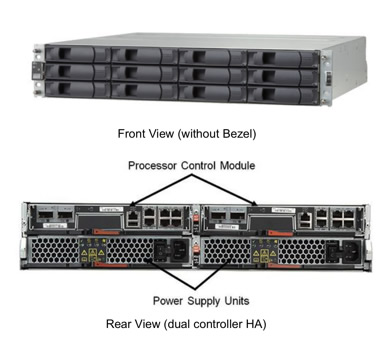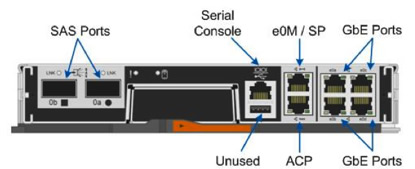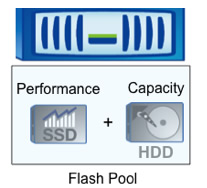


NetApp strives to deliver storage that addresses the performance and scalability needs and budget realities of the enterprise, midrange, and entry level without imposing unnecessary barriers that make it difficult or impossible to move between platforms. We achieve this by running the same Data ONTAP® operating environment and the same management tools across all FAS platforms, and by using the same or similar components wherever possible. We’re also committed to deliver enterprise-level features for reliability, availability, serviceability, and manageability (RASM) across our entire line. We think these things allow you to start right, keep it simple, and grow smart.
With the new FAS2220, we wanted to round out our entry-level offering with a platform that addresses several needs:
- Smaller IT teams get the advantages of unified storage, integrated data protection, and advanced storage efficiency in a platform that’s quick to install, easy to manage, and sized and priced for their unique requirements.
- Distributed enterprises get a storage platform that fits the needs of remote offices while improving data protection by facilitating disk-to-disk backup and/or replication to a corporate data center via NetApp SnapVault® or SnapMirror® technology.
Understanding the FAS2220

When NetApp started to design the FAS2220, we had a few goals in mind. We wanted a new entry-level system that would deliver value for smaller IT organizations, and we wanted a system that was easier and faster to set up and run than anything we’d built before. In addition, as I said in the introduction, we wanted to deliver the same RASM features we provide in the FAS6200 series and FAS3200 series in our entry-level FAS systems as well.
The result is a new system that offers clear advantages versus the FAS2020, our earlier entry-level platform. The FAS2220:
- Supports single or dual controllers plus disks in a compact 2U form factor
- Improves SAS resiliency with MP-HA for both internal and external disks
- Delivers three to seven times the performance of the FAS2020
- Includes all supported storage protocols (NFS, CIFS, iSCSI) at no additional cost
- Provides simplified management via the latest OnCommand® System Manager software
- Is cluster-ready for future growth
- Offers the new NetApp® Flash Pool capability to increase performance and decrease storage cost
- Is priced to fit any budget
Table 1) Comparison of FAS2220 and previous-generation FAS2020.
| FAS2020 HA | FAS2220 HA | |
| Processor Cores | 2 x 32-bit | 4 x 64-bit |
| Hyperthreading CPU | No | Yes |
| Physical Memory | 2GB | 12GB |
| On-Board I/O | 4 x 4Gb FC 4 x GbE | 4 x 6Gb/s SAS 8 x GbE |
| Max Disks | 68 | 60 |
| Max Capacity | 68TB | 180TB |
| Management | BMC | Service Processor (SP) |
| Data ONTAP Support | 7.2.2+, 7.3 | 8.1.1 |
| Performance | 1x | 3–7x |
Hardware
The FAS2220 features a new 2U, 12-disk chassis capable of accommodating one or two controller modules for standalone or high availability (HA) configurations.

Figure 1) FAS2220 front and rear views.
Service Analytics
The 12 large-form-factor drive carriers are the same as those used in the DS4243 and DS4246 disk shelves and the FAS2240-4 and are offered with three disk options:
- Performance HDD. 10K RPM SAS drives
- Capacity HDD. Large-capacity SATA disks
- SSD. Solid-state disks
The capacity and SSD options are the same as those used in the DS424x. Existing SSDs and capacity HDDs from these disk shelves can be migrated to a FAS2220.
The FAS2220 uses 6Gb/s SAS for all internal and external disk connections. For expansion storage, three external shelves—DS2246, DS4243, and DS4246—are supported and can be mixed on a single FAS2200 SAS stack. Up to 2 external shelves are supported for a maximum of 60 drives.
The power supply units (PSUs) used in the FAS2220 are the same as those used in the DS2246 disk shelf and the FAS2240-2. Processor Controller Modules (PCMs) use the same form factor and conform to the Storage Bridge Bay (SBB) standard.
Each PCM provides two 6Gb/s SAS ports and four Gigabit Ethernet ports. Two additional ports provide connectivity for the service processor and ACP (discussed later).

Figure 2) Rear view of FAS2220 PCM showing connectivity.
Configuration Options
Standalone. FAS2220 standalone configurations contain a single PCM in the main chassis with a controller blank in the second PCM slot to provide proper cooling. Both 6- and 12-disk configurations are available.
HA. FAS2220 HA configurations use two PCM modules in the main chassis and assign a minimum of 6 disks per controller.
In either configuration, up to 2 external disk shelves (DS424x and/or DS2246) can be added.
Table 2) The FAS2200 series.
| FAS2220 | FAS2240-2 | FAS2240-4 | |
| Form Factor | 2U | 2U | 4U |
| Chassis Depth | 20.5 in. | 19 in. | 24 in. |
| Max Storage | 180TB | 374TB | 432TB |
| Max Drive Count | 60 | 144 | 144 |
| Flash Pool Support | ✓ | ✓ | ✓ |
| Optional I/O Ports | N/A | 4 x 8Gb FC or 4 x 10 GbE | 4 x 8Gb FC or 4 x 10 GbE |
| Conv. to Disk Shelf | N/A | ✓ | ✓ |
| OS Version | Data ONTAP 8.1.1+ | Data ONTAP 8.1+ | |
Upgrades
Unlike the FAS2240, the FAS2220 cannot be converted into a disk shelf as part of an upgrade operation because the chassis is not supported as a disk shelf. However, you can migrate SSD and capacity HDD drive carriers from the FAS2220 to a DS4243 or DS4246 disk shelf and assign ownership to a new controller or you can migrate these disks into a FAS2240-4.
Software Enhancements

All FAS2220 systems run Data ONTAP 8.1.1 or later and include the Data ONTAP Essentials bundle with NFS, CIFS, and iSCSI support at no additional cost. Data ONTAP Essentials gives you immediate access to key NetApp technologies including deduplication, thin provisioning, compression, Snapshot™ copies, RAID-DP® technology, Open Systems SnapVault, MultiStore® technology, and core management tools including OnCommand Manager and OnCommand System Manager.
Ease of Management. OnCommand System Manager lets you manage NetApp storage without being a “storage expert.” Wizards and intuitive graphics guide you through configuration and ongoing administration tasks. Dashboards provide at-a-glance views of capacity, notifications, and performance.
NetApp Flash Pool Technology. The FAS2200 series (FAS2220 and FAS2240) supports Flash Pools, an exciting new feature that NetApp introduced in Data ONTAP 8.1.1. Flash Pools extend the NetApp Virtual Storage Tier (VST) approach to provide both read- and write-level caching in a NetApp aggregate and can be used by FlexVol® volumes contained in the aggregate. By adding SSDs to an aggregate, you can use economical, capacity-oriented HDDs and achieve great performance.
Flash Pool technology shares many features with Flash Cache: It works at a granularity of 4KB, provides real-time caching that adapts automatically to changes in usage, and works seamlessly with key Data ONTAP features like deduplication and FlexClone® technology. In addition, Flash Pool caches random writes to enhance write performance and provides consistent performance across HA events. (With Flash Cache the cache has to be “rewarmed” during HA takeover events.)
Figure 3) NetApp Flash Pool.
Expect to see more details about Flash Pool technology in Tech OnTap® in coming months.
Reliability, Availability, Serviceability, and Manageability

On the resiliency and availability front, we’ve added a number of features to enhance the FAS2220, bringing it on par with the FAS2240 and the FAS3200 and FAS6200 series.
Service Processor
Previous entry-level platforms had a more basic service processor than our midrange and enterprise storage platforms. Both the FAS2220 and FAS2240 use the same service processor design as our higher-end platforms. The service processor remains operational even when the rest of a storage system is down and provides capabilities such as remote power cycle, call-home notification of a down system, and always-on access for troubleshooting.
Additional features include:
- FRU reporting and tracking
- Advanced current/voltage and temperature sensor reporting
- Monitor LED status
- Force core dumps (replaces NMI button on controllers)
ACP
For out-of-band management of NetApp SAS disk shelves, all FAS systems provide NetApp Alternate Control Path (ACP) technology. ACP enhances data availability by giving a storage controller the ability to reset a storage channel without having to communicate over that channel. If a channel is down or misbehaving, a quick reset can bring it back online without external intervention. ACP allows a storage system to recover from faults that might otherwise require it to reboot, and that’s a big advantage.
ACP gives you a "back door" into your disk shelves. It is completely separate from the SAS data path and provides new options for nondisruptive recovery of shelf modules, including the ability to reset or power cycle an individual I/O module or an entire domain. We designed in the ability to power cycle an entire shelf as well. ACP technology enhances the ability of Data ONTAP to automatically reset a misbehaving component in order to return it to a fully operational mode without disruption.
Internal Processor State
From an engineering standpoint, the resiliency feature I’m most excited about is the ability to go into the processor and read out its internal state even when it’s not running. The combination of core dumps and internal processor state gives us the detailed forensics to understand exactly what is happening when a problem occurs so we can correct it. We can even single step the main CPU to pinpoint failure modes. Although you may never need to take advantage of these capabilities, they can help us isolate hardware failures much more quickly, reducing their potential impact. This type of capability is not common on entry-level storage.
System-Level Diagnostics
We’ve also included the same system-level diagnostics used on FAS3200 and FAS6200 to help you better identify hardware problems. You can run system-level diagnostics after one of the following events:
- Initial system installation
- Addition or replacement of hardware components
- System panic caused by an unidentified failure
- Access to a device that becomes intermittent or unavailable
- System response time that becomes sluggish and that other troubleshooting has not resolved
Multipath HA for Internal and External Disks
MP-HA is the capability to provide redundant paths between storage controllers and disks. MP-HA increases overall storage resiliency, and it also enables Data ONTAP to perform maintenance activities such as shelf firmware upgrades nondisruptively. Performance improves because MP-HA provides twice the bandwidth to your storage. MP-HA also load-balances the two storage paths with every GB of data transferred to maintain optimal performance.
The FAS2220 is capable of providing MP-HA for all attached disks, both internal and external, for dual-controller configurations, reducing the chance of a failover occurring as the result of path failures. Having a second path to reach storage protects against a variety of possible faults, such as:
- Port failure
- Controller-to-shelf cable failure (in configuration with multiple disk shelves)
- Shelf module failure
- Dual intershelf cable failure
- Secondary path failure (in HA configurations)
Conclusion

The FAS2220 is designed to deliver more value for smaller requirements than we’ve ever offered in an entry-level platform while providing a level of resilience normally found only in enterprise storage. The unique chassis design supports either standalone or HA configurations and up to 12 disk drives in just 2U of rack space. The new version of OnCommand System Manager simplifies setup and ongoing management, while Flash Pool technology lets you combine SSDs with HDDs to optimize both read and write performance.





